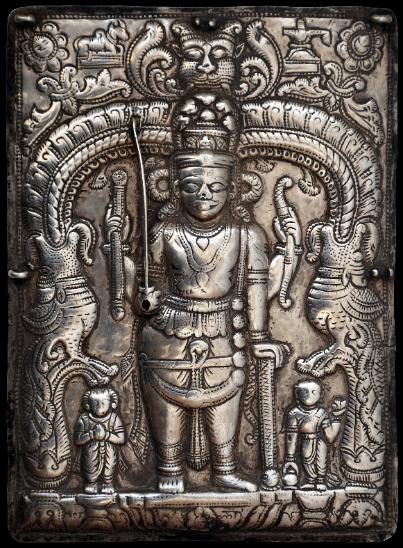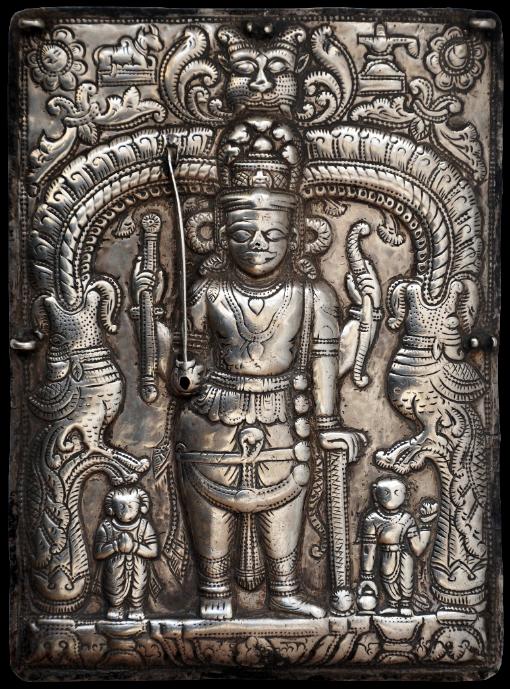
Silver Virabhadra Plaque
Silver Repousse Plaque Showing Virabhadra
India
19th century
height: 18.3cm, width: 13.4cm, weight: 224g
This excellent Virabhadra plaque in repoussed and applied silver shows excellent attention to detail. Silver is not the typical media either for such plaques, which normally are of cast brass or bronze.
Virabhadra, an incarnation of Shiva, was created after Shiva’s wife, Sati, was not invited to a great sacrifice given by her father Daksha. Sati, being greatly humiliated, went to the banquet and threw herself on the sacrificial fire. When Shiva heard of his wife’s death, he tore a hair from his head and threw it to the ground. Virabhadra, a great hero-warrior, arose from this hair. He cut off Daksha’s head in his rage and hurled it into the sacrificial fire. After the other gods calmed Shiva down, Daksha’s head was replaced by that of a goat or in this case, a ram. Daksha later became a devotee of Shiva.
Virabhadra is shown in this plaque with four hands in which he holds a bow, an arrow or a staff, a sword and a shield. The sword is constructed from a separate piece of engraved silver sheet that has been applied. A stylised multi-headed cobra rears from behind him.
Daksha, whose human head was replaced with a ram’s head, stands on Virabhadra’s right, his hands in anjali mudra. Daksha’s original head appears to be at the base of the shield that Virabhadra holds on his left.
The figure to Virabhadra’s left probably is Bhadrakali, Virabhadra’s consort. Her hands are also in anjali mudra.
A nandi and lingham adorn the upper portions of the plaque; a kurtimukha mask adorns the top. The three main standing figures are framed by two elongated makara’s from whose mouths is emitted a petal arch.
Virabhadra’s clothing and ornaments are shown in some detail. He has chest ornaments, arm ornaments, anklets, large coiled earrings and a crown, as well as a pleated waist cloth and a dhoti.
The figures all stand within a wide, raised border that is chased with floral and petal motifs.
The plaque is adorned with five eyelets or lugs. Either these were to attach the plaque or were used to hold small feathers of flowers to adorn the plaque.
Overall, this is a fine, unusual piece with some puja (prayer) wear. Most probably it adorned a household shrine or a small shrine within a temple.
References
Pal, P., Art from the Indian Subcontinent: Asian Art at the Simon Norton Museum, Volume 1, Yale University Press, 2003.
Provenance
UK art market
Inventory no.: 1298
SOLD



